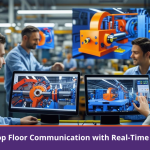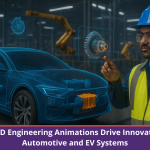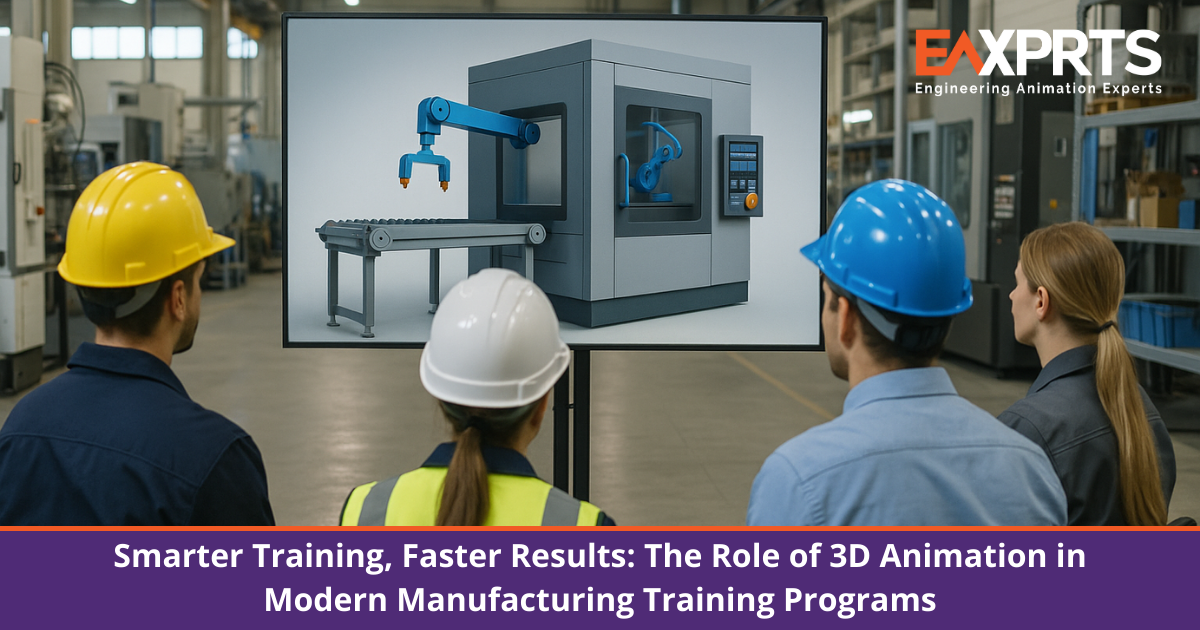
Enhancing Shop Floor Communication with Real-Time 3D Visual Aids
August 5, 2025
How 3D Engineering Animations Drive Innovation in Automotive and EV Systems
August 26, 2025Smarter Training, Faster Results: The Role of 3D Animation in Modern Manufacturing Training Programs
Manufacturing is evolving faster than ever, with new technologies, processes, and machinery being introduced to meet growing demands for efficiency, precision, and sustainability. Alongside this evolution, the need for effective workforce training has never been greater. Traditional training methods, manuals, classroom lectures, and job shadowing, often fail to keep pace with modern manufacturing complexity. They can be time-consuming, inconsistent, and, in some cases, risky.
This is where 3D animation in manufacturing training steps in. By combining visual storytelling with interactive learning tools, 3D engineering animation has transformed training into a smarter, faster, and more effective process.
Why Traditional Manufacturing Training Falls Short
Before exploring how 3D animation enhances training, it’s important to understand the limitations of traditional methods:
- Manuals and 2D diagrams are hard to interpret, especially for complex assemblies and processes.
- Classroom-style lectures offer limited engagement and retention.
- On-the-job training risks downtime, safety hazards, and costly mistakes.
- Training quality depends heavily on the instructor, leading to inconsistency across teams.
For companies striving for operational excellence, these limitations create significant challenges in knowledge transfer, workforce readiness, and productivity.
The Role of 3D Animation in Modern Training
3D engineering animation addresses these challenges by providing an immersive, visual, and consistent approach to training. Unlike static documents, 3D animations bring machines, processes, and safety protocols to life, making them easier to understand and apply.
Key roles of 3D animation in manufacturing training include:
- Visualizing complex systems: Break down machines, assemblies, or entire plants into digestible sequences.
- Interactive learning: Allow employees to explore procedures at their own pace.
- Safe training environments: Simulate hazardous conditions without real-world risks.
- Standardized content delivery: Ensure uniform training across plants and locations.
Key Benefits of 3D Animation for Manufacturing Training
The adoption of 3D animation for training programs offers measurable benefits that directly impact manufacturing performance:
- Faster Learning Curve
Employees grasp technical knowledge quicker when complex processes are explained with animated visualizations instead of lengthy text.
- Higher Retention & Engagement
Studies show that visual learning improves retention by up to 65%. 3D animated training modules are more engaging than manuals, ensuring that critical information stays with trainees.
- Reduced Downtime
Instead of halting production for on-site training, employees can learn through 3D training modules—minimizing disruption to operations.
- Cross-Functional Applications
From shop-floor operators and maintenance engineers to managers and new hires, 3D animation training content can be tailored for different audiences.
- Scalability
A single 3D training module can be reused across global facilities, making training cost-efficient and scalable.
Real-World Applications of 3D Training in Manufacturing
Assembly & Disassembly Training
3D animations demonstrate each step in assembly processes, showing how components fit together. This reduces errors, improves accuracy, and accelerates learning.
Safety & Compliance Training
Employees can be trained on safety protocols, emergency procedures, and equipment handling through realistic animated simulations, reducing risks of accidents.
Maintenance & Troubleshooting
Animated modules visually guide engineers through preventive maintenance and predictive maintenance workflows, reducing equipment downtime and improving reliability.
Onboarding & Induction
New employees can virtually tour the plant, understand workflows, and learn best practices even before entering the shop floor. This cuts down induction time while ensuring workforce readiness.
Integration with Digital Learning Ecosystems
The power of 3D training modules multiplies when integrated with digital learning platforms:
- Learning Management Systems (LMS): Track progress, measure performance, and provide assessments linked to 3D content.
- Virtual & Augmented Reality (VR/AR): Combine 3D animations with immersive training environments where employees can practice tasks in a safe, simulated space.
- Remote Training: Cloud-based 3D training allows employees to learn anytime, anywhere—ideal for global manufacturing operations.
This integration ensures that 3D animation training is not just a visual tool but a core component of smart workforce development strategies.
Case Example: Faster Training, Real Results
A global automotive manufacturer recently replaced traditional manuals with 3D animated training content for its assembly line workers. Within six months:
- Training time for new employees dropped by 40%.
- Error rates during assembly reduced by 25%.
- Employee satisfaction with training increased significantly.
The results highlight how 3D animation transforms manufacturing training programs from being a cost center into a value-driving initiative.
The Future of Manufacturing Training with 3D Animation
As digital transformation accelerates, 3D animation in manufacturing training will continue to evolve with emerging technologies:
- AR/VR-enabled training labs offering real-time simulations of factory operations.
- AI-powered adaptive learning, where training modules adjust based on employee performance.
- Remote global collaboration—virtual training rooms where teams across different countries train together.
These advancements will make workforce training more immersive, personalized, and effective, ensuring manufacturers can upskill employees quickly and stay competitive.
Conclusion
The demands of modern manufacturing call for smarter training solutions that deliver faster results without compromising safety, efficiency, or consistency. By replacing outdated training models with 3D animation-based training programs, manufacturers can accelerate knowledge transfer, minimize risks, and boost workforce productivity.
3D engineering animation bridges the gap between complex technical knowledge and real-world application—making training not only more efficient but also more engaging and impactful.
Talk to us today! Reach us on sales@eaxprts.com



